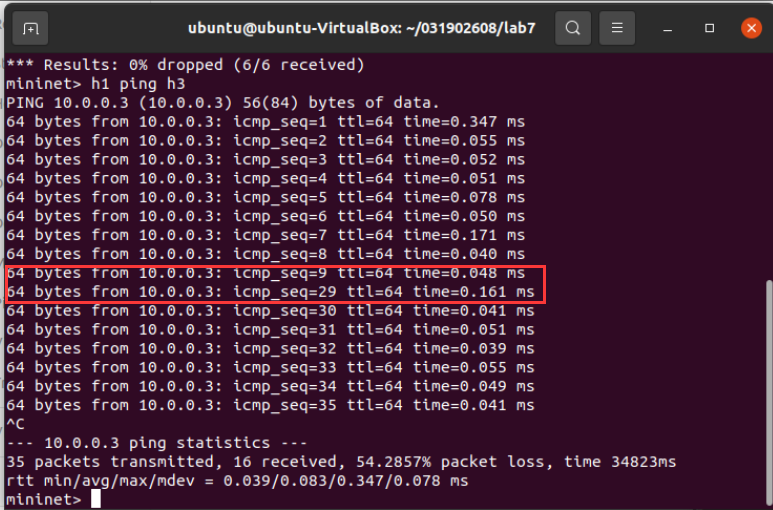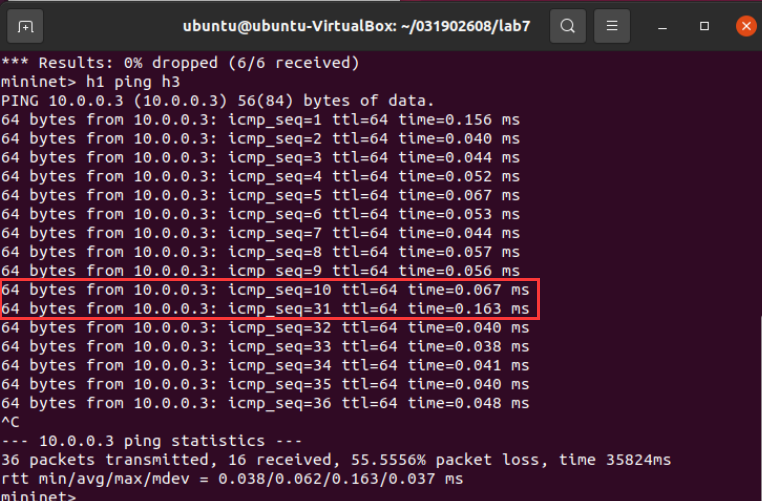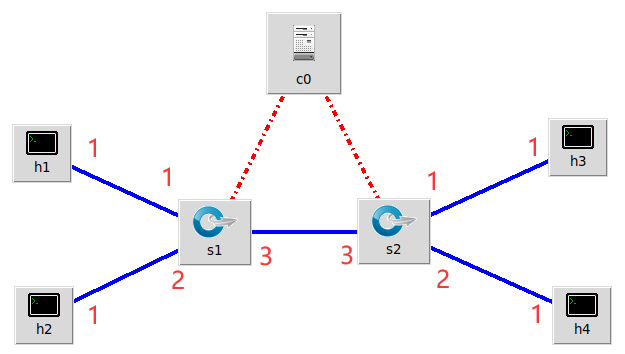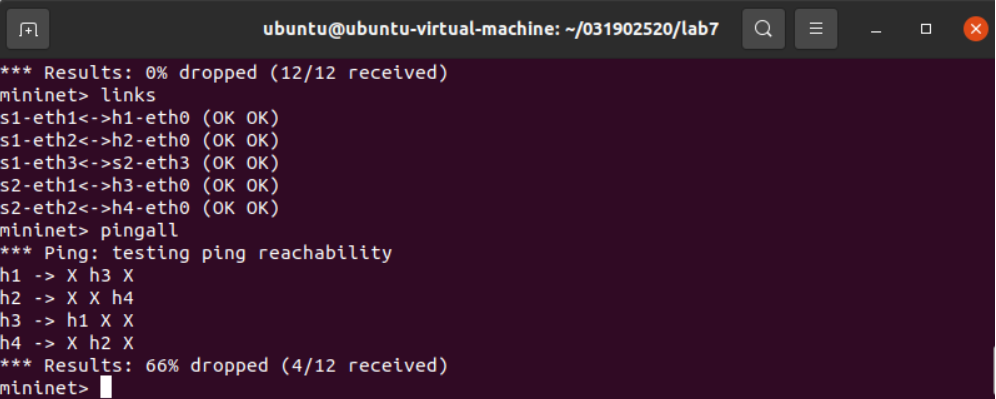实验7:基于REST API的SDN北向应用实践
实验7:基于REST API的SDN北向应用实践
一、实验目的
- 能够编写程序调用OpenDaylight REST API实现特定网络功能;
- 能够编写程序调用Ryu REST API实现特定网络功能。
二、实验环境
- 下载虚拟机软件Oracle VisualBox或VMware;
- 在虚拟机中安装Ubuntu 20.04 Desktop amd64,并完整安装Mininet、OpenDaylight(Carbon版本)、Postman和Ryu;
三、实验要求
基本要求
- OpenDaylight
(1) 利用Mininet平台搭建下图所示网络拓扑,并连接OpenDaylight;

(2) 编写Python程序,调用OpenDaylight的北向接口下发指令删除s1上的流表数据。
#delete.py import requests from requests.auth import HTTPBasicAuth def http_delete(url): url= url headers = {'Content-Type':'application/json'} resp = requests.delete(url,headers=headers,auth=HTTPBasicAuth('admin', 'admin')) return resp if __name__ == "__main__": url='http://127.0.0.1:8181/restconf/config/opendaylight-inventory:nodes/node/openflow:1/' resp = http_delete(url) print (resp.content)
(3) 编写Python程序,调用OpenDaylight的北向接口下发硬超时流表,实现拓扑内主机h1和h3网络中断20s。
#timeout.py import requests from requests.auth import HTTPBasicAuth def http_put(url,jstr): url= url headers = {'Content-Type':'application/json'} resp = requests.put(url,jstr,headers=headers,auth=HTTPBasicAuth('admin', 'admin')) return resp if __name__ == "__main__": url='http://127.0.0.1:8181/restconf/config/opendaylight-inventory:nodes/node/openflow:1/flow-node-inventory:table/0/flow/1' with open('h1_ping_h3_timeout.json') as f: jstr = f.read() resp = http_put(url,jstr) print (resp.content)
{ "flow": [ { "id": "1", "match": { "in-port": "1", "ethernet-match": { "ethernet-type": { "type": "0x0800" } }, "ipv4-destination": "10.0.0.3/32" }, "instructions": { "instruction": [ { "order": "0", "apply-actions": { "action": [ { "order": "0", "drop-action": {} } ] } } ] }, "flow-name": "flow1", "priority": "65535", "hard-timeout": "20", "cookie": "2", "table_id": "0" } ] }
(4) 编写Python程序,调用OpenDaylight的北向接口获取s1上活动的流表数。
#get.py import requests from requests.auth import HTTPBasicAuth if __name__ == "__main__": url = 'http://127.0.0.1:8181/restconf/operational/opendaylight-inventory:nodes/node/openflow:1/flow-node-inventory:table/0/opendaylight-flow-table-statistics:flow-table-statistics' headers = {'Content-Type': 'application/json'} res = requests.get(url,headers=headers, auth=HTTPBasicAuth('admin', 'admin')) print (res.content)
- Ryu
(1) 编写Python程序,调用Ryu的北向接口,实现上述OpenDaylight实验拓扑上相同的硬超时流表下发。
#ryu_timeout.py import requests from requests.auth import HTTPBasicAuth def http_post(url,jstr): url= url headers = {'Content-Type':'application/json'} resp = requests.post(url,jstr,headers=headers) return resp if __name__ == "__main__": url='http://127.0.0.1:8080/stats/flowentry/add' with open('ryu_timeout.json') as f: jstr = f.read() resp = http_post(url,jstr) print (resp.content)
{ "dpid": 1, "cookie": 1, "cookie_mask": 1, "table_id": 0, "hard_timeout": 20, "priority": 65535, "flags": 1, "match":{ "in_port":1 }, "actions":[ { "type":"OUTPUT", "port": 2 } ] }
(2) 利用Mininet平台搭建下图所示网络拓扑,要求支持OpenFlow 1.3协议,主机名、交换机名以及端口对应正确。拓扑生成后需连接Ryu,且Ryu应能够提供REST API服务。

拓扑
(3) 整理一个Shell脚本,参考Ryu REST API的文档,利用curl命令,实现和实验2相同的VLAN。
VLAN_ID Hosts 0 h1 h3 1 h2 h4
curl -X POST -d '{ "dpid": 1, "priority": 1, "match":{ "in_port": 1 }, "actions":[ { "type": "PUSH_VLAN", "ethertype": 33024 }, { "type": "SET_FIELD", "field": "vlan_vid", "value": 4096 }, { "type": "OUTPUT", "port": 3 } ] }' http://localhost:8080/stats/flowentry/add curl -X POST -d '{ "dpid": 1, "priority": 1, "match":{ "in_port": 2 }, "actions":[ { "type": "PUSH_VLAN", "ethertype": 33024 }, { "type": "SET_FIELD", "field": "vlan_vid", "value": 4097 }, { "type": "OUTPUT", "port": 3 } ] }' http://localhost:8080/stats/flowentry/add curl -X POST -d '{ "dpid": 1, "priority": 1, "match":{ "vlan_vid": 0 }, "actions":[ { "type": "POP_VLAN", "ethertype": 33024 }, { "type": "OUTPUT", "port": 1 } ] }' http://localhost:8080/stats/flowentry/add curl -X POST -d '{ "dpid": 1, "priority": 1, "match":{ "vlan_vid": 1 }, "actions":[ { "type": "POP_VLAN", "ethertype": 33024 }, { "type": "OUTPUT", "port": 2 } ] }' http://localhost:8080/stats/flowentry/add curl -X POST -d '{ "dpid": 2, "priority": 1, "match":{ "in_port": 1 }, "actions":[ { "type": "PUSH_VLAN", "ethertype": 33024 }, { "type": "SET_FIELD", "field": "vlan_vid", "value": 4096 }, { "type": "OUTPUT", "port": 3 } ] }' http://localhost:8080/stats/flowentry/add curl -X POST -d '{ "dpid": 2, "priority": 1, "match":{ "in_port": 2 }, "actions":[ { "type": "PUSH_VLAN", "ethertype": 33024 }, { "type": "SET_FIELD", "field": "vlan_vid", "value": 4097 }, { "type": "OUTPUT", "port": 3 } ] }' http://localhost:8080/stats/flowentry/add curl -X POST -d '{ "dpid": 2, "priority": 1, "match":{ "vlan_vid": 0 }, "actions":[ { "type": "POP_VLAN", "ethertype": 33024 }, { "type": "OUTPUT", "port": 1 } ] }' http://localhost:8080/stats/flowentry/add curl -X POST -d '{ "dpid": 2, "priority": 1, "match":{ "vlan_vid": 1 }, "actions":[ { "type": "POP_VLAN", "ethertype": 33024 }, { "type": "OUTPUT", "port": 2 } ] }' http://localhost:8080/stats/flowentry/add

实验总结
遇到的困难:1.使用curl删除的时候流表的时候报错.curl: (3) Illegal characters found in URL : not found3: 2.无法直接使用python文件生成拓扑并连接ryu控制器。
3.运行shell脚本的时候报错,curl: (7) Failed to connect to localhost port 8080: Connection refused
4.连接ryu控制器后一直ping不通。
3.运行shell脚本的时候报错,curl: (7) Failed to connect to localhost port 8080: Connection refused
4.连接ryu控制器后一直ping不通。
解决方法: 1.使用vi进入脚本,发现每行末尾都有一个^M。手动删去每行末尾的'^M',然后:wq保存就解决了。
2.参考了同学的代码,输入sudo mn --custom topo.py --topo mytopo --mac --controller=remote,ip=127.0.0.1,port=8080 --switch ovsk,protocols=OpenFlow13来生成拓扑。
3.不是很清楚怎么解决的,重启虚拟机之后重新弄了一遍就没报错了。
4.问了同学,他告诉我说一直输入put命令就能解决,不是很懂。
个人感想:本次实验感觉十分困难,总是碰到一些问题,然后重做好几次。这次使用的OpenDaylight和Ryu,虽然在之前的实验已经使用过,但是还是花了不少时间复习才回忆起来,感觉自己对知识还没有完全掌握。在写代码方面也是挺困难的,问同学并且参考同学的代码才能写出来。还得更加努力啊。

